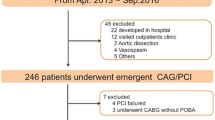Abstract
The door-to-balloon time and total ischemic time are important predictors of the outcome in patients with ST elevation myocardial infarction (STEMI) receiving primary angioplasty, but the current situation in Japan is unknown. The Japan Acute Myocardial Infarction registry is a prospective observational study of 2,030 consecutive STEMI patients admitted to 213 Japanese institutions. The time from symptom onset to hospital arrival, door-to-balloon time, and in-hospital outcome were assessed. Data were compared between patients treated during regular hours or after hours. Percutaneous coronary angioplasty was done in 97.2 % of the patients, using drug-eluting stents in 30 % and bare metal stents in 63 % of the treated cases. The median symptom onset-to-door time (25th and 75th percentiles) was 135 min (64–305 min), median door-to-balloon time was 42 min (28–66 min), and mean procedural time was 98 ± 51 min. The on-call catheterization team performed 48.5 % of the procedures. There was no significant difference of door-to-balloon time between the patients treated after hours and those treated during regular hours. The cardiac mortality rate was 3.2 %, and it increased with longer door-to-balloon times (P = 0.03). The relationship between total ischemic time and cardiac mortality showed 2 peaks, with a trough at 5 h. Median door-to-balloon time was <90 min and was not longer in after hours cases. These findings suggest that Japanese institutions can provide primary angioplasty within an acceptable time frame.





Similar content being viewed by others
References
American Heart Association. Heart disease and stroke statistics: 2006 update. Circulation. 2006;113:e85–151.
Denktas AE, Anderson HV, McCarthy J, Smalling RW. Total ischemic time. The correct focus of attention for optimal ST-segment elevation myocardial infarction care. J Am Coll Cardiol Intv. 2011;4:599–604.
Hasche ET, Fernandes C, Freedman SB, Jeremy RW. Relation between ischemia time, infarct size, and left ventricular function in humans. Circulation. 1995;92:710–9.
Liem AL, van’t Hof AWJ, Hoorntje JC, de Boer MJ, Suryapranata H, Zijlstra F. Influence of treatment delay on infarct size and clinical outcome in patients with acute myocardial infarction treated with primary angioplasty. J Am Coll Cardiol. 1998;32(629):633.
Rathore SS, Curtis JP, Chen J, Wang Y, Nallamothu BK, Epstein AJ, et al. Association of door-to-balloon time and mortality in patients admitted to hospital with ST elevation myocardial infarction: national cohort study. BMJ. 2009;338:b1807.
Antman EM, Hand M, Armstrong PW, Bates ER, Green LA, Halasyamani LK, et al. 2007 focused updated of the ACC/AHA 2004 guidelines for the management of patients with ST-elevation myocardial infarction: a report of the American College of Cardiology/American Heart Association Task Force on Practice Guidelines: 2007 Writing Group to review new evidence and update the ACC/AHA 2004 Guidelines for the management of patients with ST-elevation myocardial infarction. J Am Coll Cardiol. 2008;51:210–47.
Magid DJ, Wang Y, Herrin J, McNamara RL, Bradley EH, Curtis JP, et al. Relationship between time of day, day of week, timeliness of reperfusion, and in-hospital mortality for patients with acute ST-segment elevation myocardial infarction. JAMA. 2005;294:803–12.
Nallamothu BK, Bates ER, Herrin J, Wang Y, Bradley EH, Krumholz HM. Times to treatment in transfer patients undergoing primary percutaneous coronary intervention in the United States: National Registry of Myocardial Infarction (NRMI) analysis. Circulation. 2005;111:761–7.
Jacoby J, Axelband J, Patterson J, Belletti D, Heller M. Cardiac catheterization lab activation by the emergency physician without prior consultation decreases door-to-balloon time. J Invasive Cardiol. 2005;17:154–5.
Khot UN, Johnson ML, Ramsey C, Khot MB, Todd R, Shaikh SR, et al. Emergency department physician activation of the catheterization laboratory and immediate transfer to an immediately available catheterization laboratory reduce door-to-balloon time in ST-elevation myocardial infarction. Circulation. 2007;116:67–76.
Bradley EH, Herrin J, Wang Y, Barton B, Webster TR, Mattera JA, et al. Strategies for reducing door-to balloon time in acute myocardial infarction. N Engl J Med. 2006;355:2308–20.
Holmes DR, Bell MR, Gresh BJ, DPHIL C, Rihal CS, Haro LH, et al. Reperfusion therapy for ST-segment elevation myocardial infarction during off hours. The Mayo clinic STEMI protocol. JACC Cardiovasc Interv. 2008;1:88–96.
Kostis WJ, Demissie K, Marcella SW, Shao Y-H, Wilson AC, Moreyra AE, for the Myocardial Infarction Data Acquisition System (MIDAS 10) Study Group. Weekend versus weekday admission and mortality from myocardial infarction. N Engl J Med. 2007;356:1099–109.
Brodie BR, Stuckey TD, Muncy DB, Hansen CJ, Wall TC, Pulsipher M, et al. Importance of time to reperfusion in patients with acute myocardial infarction with and without cardiogenic shock treated with primary percutaneous coronary intervention. Am Heart J. 2003;145:708–15.
De Luca G, Suryapranata H, Ottervanger JP, Antman EM. Time delay to treatment and mortality in primary angioplasty for acute myocardial infarction: every minute of delay counts. Circulation. 2004;109:1223–5.
De Luca G, Suryapranata H, Zijlstra F, van’t Hof AWJ, Hoorntje JCA, Gosselink ATM, et al., for the ZWOLLE Myocardial Infarction Study Group. Symptom-onset-to-balloon time and mortality in patients with acute myocardial infarction treated by primary angioplasty. J Am Coll Cardiol. 2003;42:991–7.
Cannon CP, Gibson CM, Lambrew CT, Shoultz DA, Levy D, French WJ, et al. Relationship of symptom-onset-to-balloon time and door-to-balloon time with mortality in patients undergoing angioplasty for acute myocardial infarction. JAMA. 2000;283:2941–7.
Berger PB, Ellis SG, Holmes DR, Granger CB, Criger DA, Betriu A, et al. Relationship between delay in performing direct coronary angioplasty and early clinical outcome in patients with acute myocardial infarction: results from the global use of strategies to open occluded arteries in acute coronary syndrome (GUSTO-IIb) trial. Circulation. 1999;100:14–20.
Brodie BR, Stone GW, Morice MC, Cox DA, Garcia E, Mattos LA, et al. Importance of time to reperfusion on outcomes with primary coronary angioplasty for acute myocardial infarction (results from the Stent Primary Angioplasty in Myocardial Infarction Trial). Am J Cardiol. 2001;88:1085–90.
Eitel I, Desch S, Fuernau G, Hildebrand L, Gutberlet M, Schuler G, et al. Prognostic significance and determinants of myocardial salvage assessed by cardiovascular magnetic resonance in acute reperfused myocardial infarction. J Am Coll Cardiol. 2010;55:2470–9.
Austin PC, Mamdani MM, van Walraven C, Tu JV. Quantifying the impact of survivor treatment bias in observational studies. J Eval Clin Pract. 2006;12:601–12.
Acknowledgments
This study was supported by Sanofi-Aventis, and was coordinated by the Japanese Society of Cardiovascular Intervention and Therapeutics. The authors were solely responsible for the design and conduct of this study, for all analyses, for drafting and editing the manuscript, and for the final contents.
Author information
Authors and Affiliations
Corresponding author
Additional information
For the Japanese Acute Myocardial Infarction (J-AMI) registry.
Electronic supplementary material
Below is the link to the electronic supplementary material.
Rights and permissions
About this article
Cite this article
Nakamura, M., Yamagishi, M., Ueno, T. et al. Current treatment of ST elevation acute myocardial infarction in Japan: door-to-balloon time and total ischemic time from the J-AMI registry. Cardiovasc Interv and Ther 28, 30–36 (2013). https://doi.org/10.1007/s12928-012-0128-x
Received:
Accepted:
Published:
Issue Date:
DOI: https://doi.org/10.1007/s12928-012-0128-x




